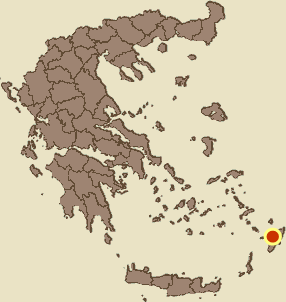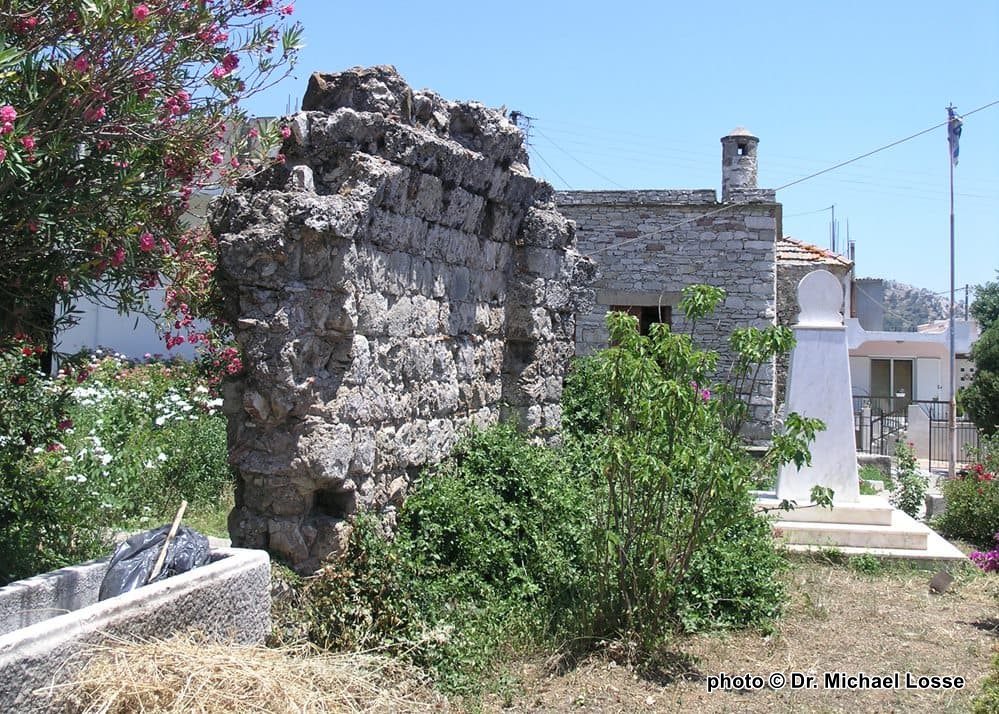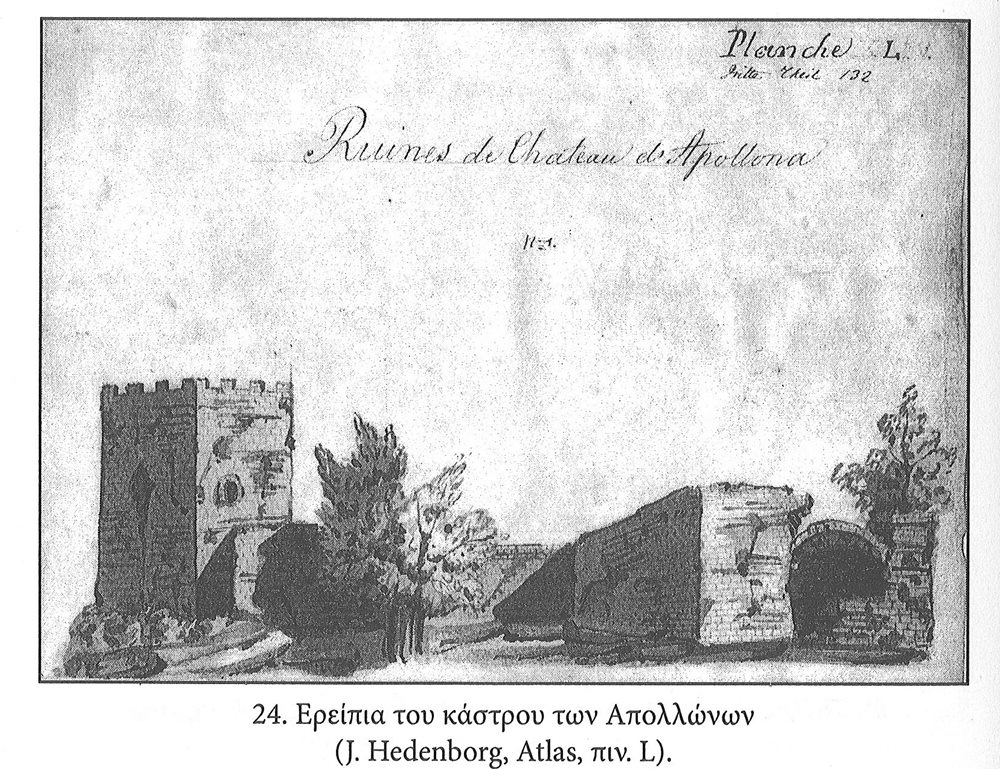Apóllona, Rhodes, Dodecanese,South Aegean
Castle of Apollona
| Location: |
| Inside the village Apóllona in Rhodes island |
| Region > Prefecture: |  |
| South Aegean Dodecanese | |
| Municipality > Town: | |
| City of Rhodes • Apóllona | |
| Altitude: | |
|
Elevation ≈ 315 m (Relative Height≈0 m) |
| Time of Construction | Origin | |
| c. end of 15th cent. | IOANNITE |
|
| Castle Type | Condition | |
| Castle Ruins |
In Ruins
|
Ruins of a four-winged castle of the Chivalric Order of St. John inside the village, partly covered with residential buildings; part of the complex is now used as a museum.
Castle Description
Text: Dr. Michael Losse – Singen (Hohentwiel), GermanyGeneral description
Apóllona is located on the south side of the Profítis Ilías Mountain, the third highest mountain on Rhodes. “The village is located in a wide fertile meadow, between orchards and grain fields, quite lonely and away from all roads”, this was how the German traveller, artist and researcher Albert Berg (1862, pages 100 and 99) saw the village, which at that time numbered 70 houses, surrounded by “beautiful tree gardens”. A few years earlier, the German archaeologist Prof. Ludwig Ross (1845) visited the village “under manifold fruit trees in a cauldron at the southern foot of the mountain range of the Prophet Elias” in which “despite the name [...] nothing Hellenic was to be asked for” (Ross 1845, Vol. III, p. 110). The village was mentioned in late medieval scriptural sources in 1314 and 1474 (cf. Alexandra Stefanidou 2002, p. 211).
In the nowadays village there are numerous fragments of ancient buildings in front of the fire station and at the sports field.
In the middle of the extensive village are the remains of the Knights Hospitallers’ castle, which are integrated into the local history museum. Originally the castle stood outside the village that had grown strongly in recent decades. Prof. Ross (1845, p. 110) saw “above the village"” a “tower and some remains of a very destroyed knight's castle”, and Albert Berg (1862, p. 100) mentioned a “beautiful castle from the Knights Hospitallers’ period [...] near the village”.
Like the castle at Sálakos (Rhodes) the castle Apóllona was among the rectangular complexes without flanking towers, which consisted of four single-storey, barrel-vaulted wings, whose roofs probably served as defensive platforms. A drawing of the Swedish researcher and medical doctor Dr. Johan Hedenborg (1854) shows the nearly square castle with rectangular, two- to three-storey tower with small merlons next to ruins of barrel-vaulted buildings. Berg (1862) described it as “like most of the castles intended to accommodate the inhabitants of the countryside, of a square floor plan; four vaulted halls enclose a spacious courtyard where the villagers and their herds of animals found space; outside, the construction has about a hundred steps on each side.”
Due to the loss of its function as a castle and later built residential buildings inside, which house the local museum, the castle is hardly noticeable as a once detached building complex, especially since it stands within the edge of a street. Parts of the east, west and north walls were preserved, as were approaches to barrel vaults.
Access (route / entrance)
The castle ruins with the museum (Odos 28 Oktobriou 15) are located about 40 m below the thoroughfare.
Open only by telephone advance booking; Entrance fee.
History of the castle
The castle was built by the Order of the Knights of St. John (Hospitaller Knights) maybe in the 15th century to protect the villagers against Ottoman and pirate raids.
Other Info
SourcesLosse, Michael: Die Burgen und Festungen des Johanniter-Ritterordens auf Rhódos und in der Ägäis (Griechenland) 1307-1522. (Publisher: Nünnerich-Asmus Verlag) Mainz 2017.
Losse, Michael: Kástro Apóllona – Johanniter-Ordensburg, www.burgenwelt.org/griechenland/apollona/object.php (created: 2020.11.21).
Ross, Ludwig: Reisen auf den griechischen Inseln des ägäischen Meeres. Dritter Band [= Vol. III]. Enthaltend Melos, Kimolos, Thera, Kasos, Karpathos, Rhodos, Chalke, Syme, Kos, Kalymnos, Ios (Reisen und Länderbeschreibungen in der älteren und neuesten Zeit, eine Sammlung der interessantesten Werke über Länder- und Staaten-Kunde, Geographie und Statistik, 31. Lieferung). Stuttgart und Tübingen 1845.
Stefanidou, Alexandra: Castles of the Knights Hospitallers. In: Anna Triposkoufi/Amalia Tsitouri (Ed.): Venetians and Knights Hospitallers. Athens 2002, pp. 184-253.
ΣΤΕΦΑΝΙΔΟΥ, Αλεξάνδρα Στ.:Η Μεσαιωνική Ρόδος. Με βάση το χειρόγραφο και την εικονογράφηση του Johannes Hedenborg (1854). / The Medieval Rhodes. Based on the Manuscript and Illustrations of Johannes Hedenborg (1854). 2004.
Photos
No. 1,2 and 3 (photo © Dr. Michael Losse, 2007-08)
Picture No. 4:
Ruines de Chateau d’Apollona, historical illustration in the museum; from: Johan Hedenborg: Geschichte der Insel Rhodos von der Urzeit bis auf die heutigen Tage nebst einer historischen Uebersicht der Völker Griechen, Römer, Araber, Franken und Türken, welche die Inseln beherrscht haben: mit einer Sammlung vieler Inscriptionen so wie vieler Abbildungen von Monumenten besonders aus Mittel-Alter von Joh. Hedenborg Prof. Med. und Chirurg. Doctor Ritter Meheren Orden und Mitglied meher Akadem und Gesellschaften (= History of the island of Rhodes from prehistoric times to the present day, along with a historical overview of the peoples of The Greeks, Romans, Arabs, Franks and Turks who ruled the islands: with a collection of many inscriptions as well as many illustrations of monuments especially from the middle age of Joh. Hedenborg Prof. Med. and Surgeon. Doctor Knight Meheren Order and Member meher Academics and Societies). 1854 Autogr. Handwriting – Atlas. [Rhodos 1854]. – On Hedenborg's drawing, the tower of the castle is still preserved.
| First entry in Kastrologos: | December 2020 |
Sources
- Text and photographs (2007, 2008) by Dr. Michael Losse
|
|
| Access |
|---|
| Entrance: |
| Free access |





